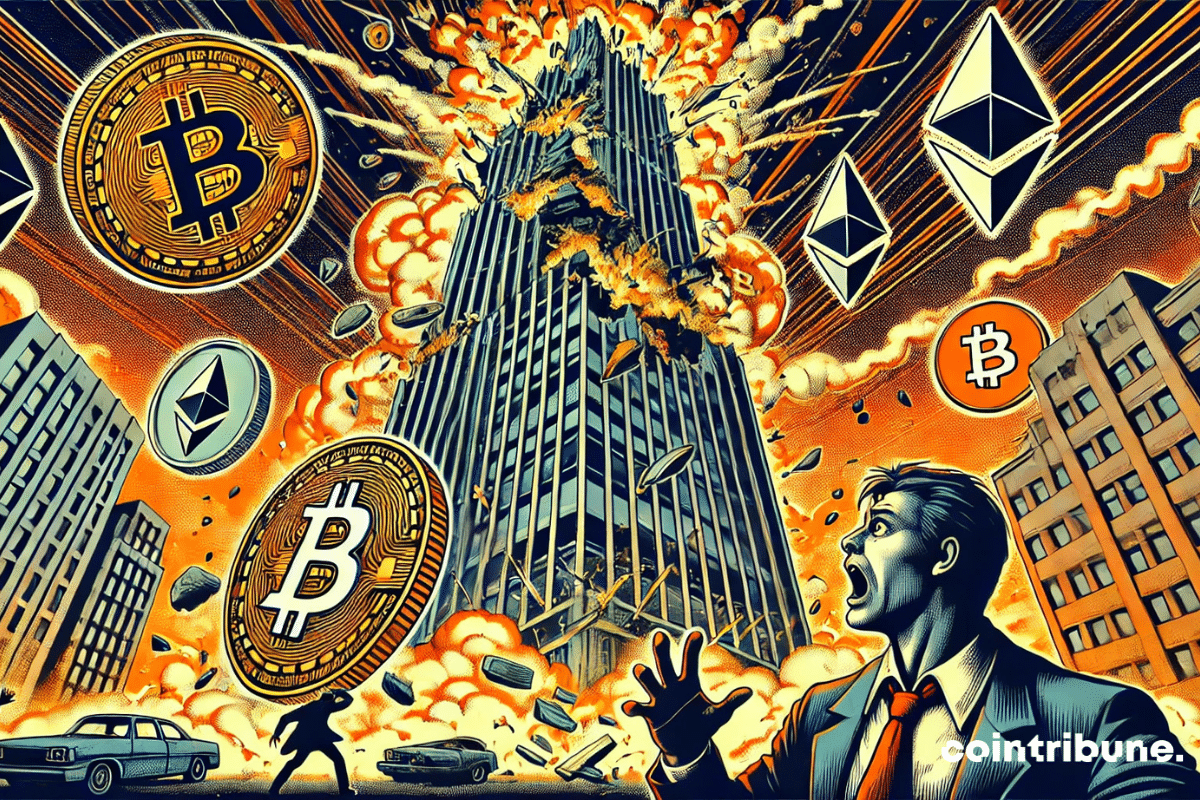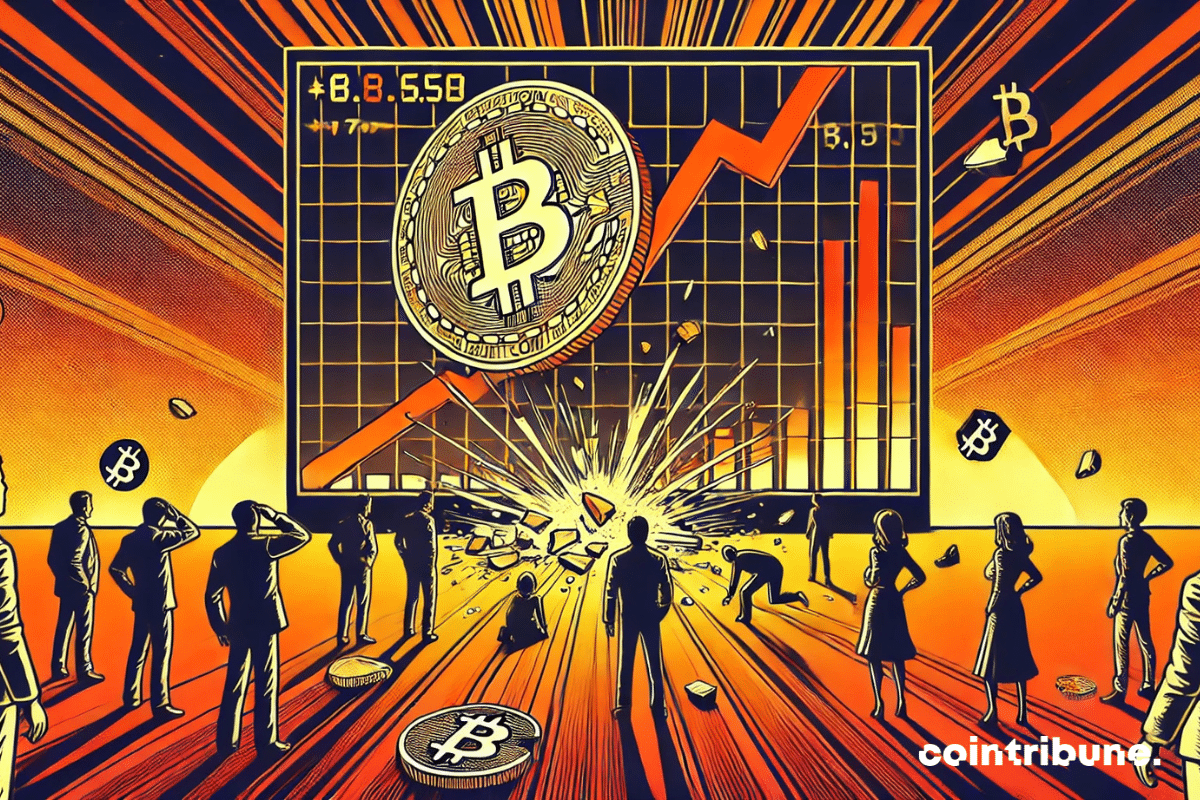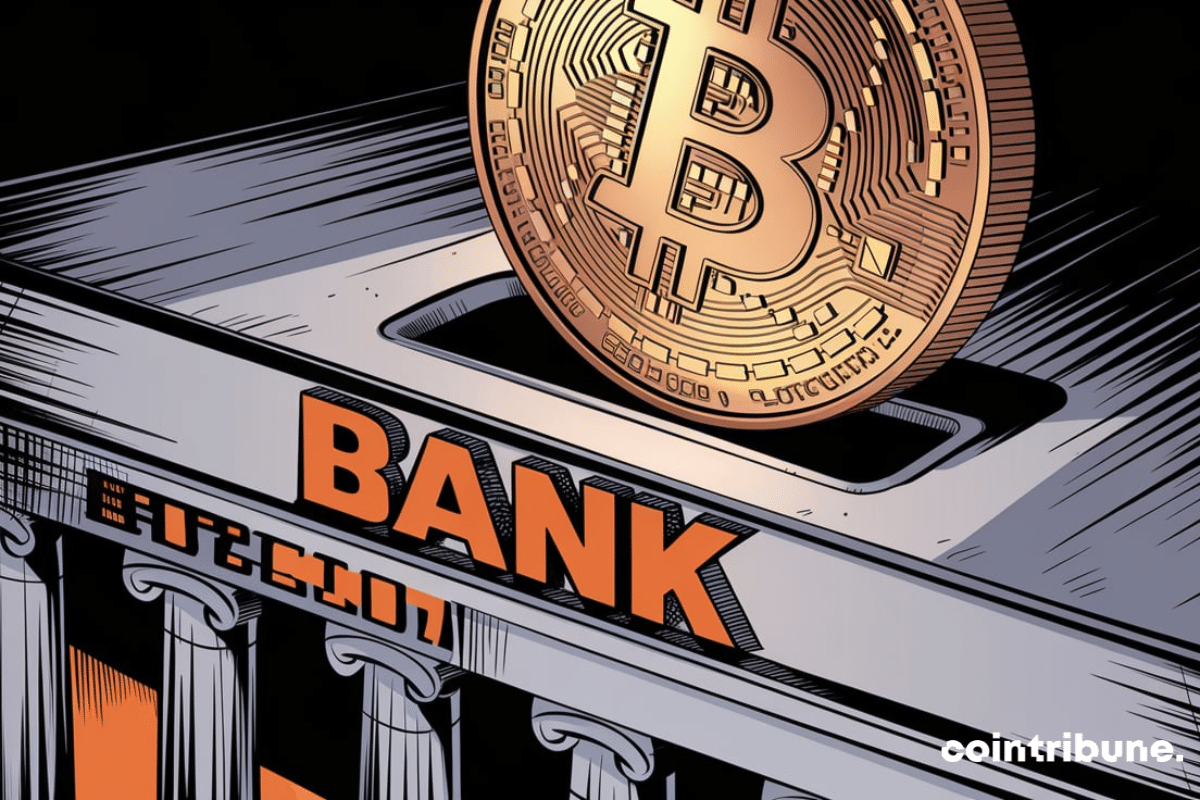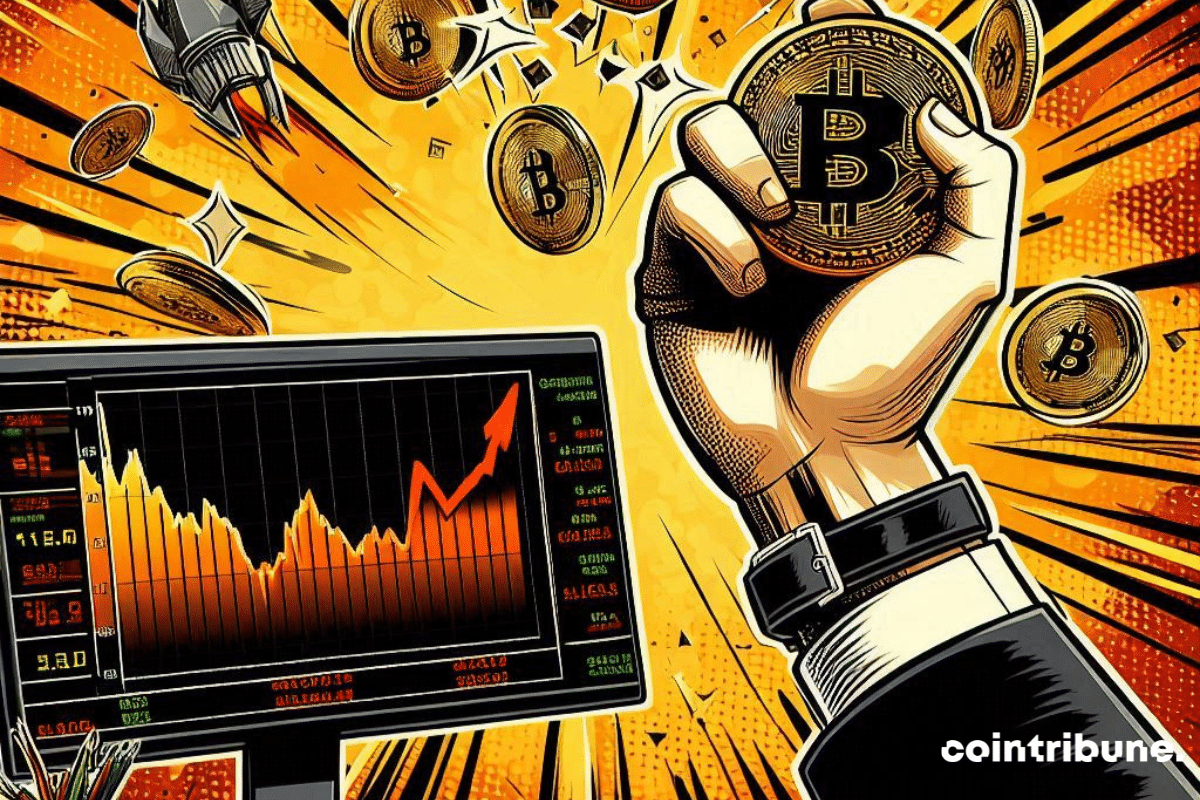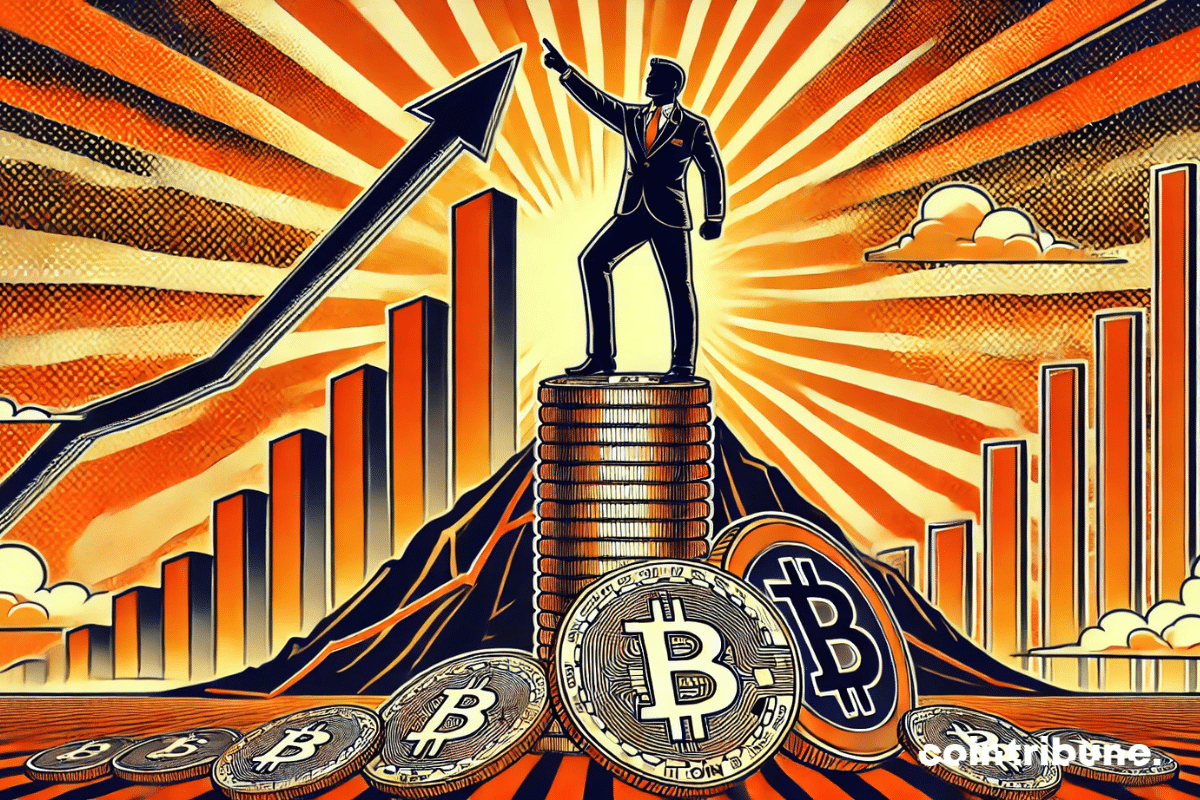The recent drop of Bitcoin below the symbolic threshold of $98,000 has caught the attention of investors. On-chain data, however, reveals a remarkable absence of panic selling, suggesting a temporary correction rather than a major trend reversal.
Theme Bitcoin (BTC)
As Bitcoin remains at the heart of discussions about the future of the global financial landscape, MicroStrategy is ramping up its commitment and announcing a new ambitious initiative. The American company plans to raise funds through an offering of 2.5 million preferred shares, a mechanism designed to finance the acquisition of new bitcoins and bolster its operations. This move, driven by a clear strategy of diversification around cryptocurrencies, comes in a context of declining revenues and shrinking profit margins. By choosing Bitcoin as the cornerstone of its treasury, MicroStrategy reaffirms its long-term vision and raises questions about the potential risks and repercussions of this bold model.
When Trump decrees, cryptos ignite: Bitcoin recently at $109,000, ETPs feast on $1.9 billion.
Bitcoin (BTC) started the last week of January with a significant drop below $100,000, reaching its lowest point in 10 days. Even though the queen of crypto slightly rebounded to $100,000, investors are navigating an environment of increasing tension! Between market volatility and uncertainties from the Federal Reserve... Here are 5 things to know about Bitcoin this week.
The cryptocurrency XRP is making headlines again despite the fact that the Lightning Network has rendered it completely useless for a long time...
Cryptos are once again captivating attention as 2025 promises to be rich in upheavals. Thus, Bitcoin, Solana, and XRP, close to their historical peaks, could enter a phase of accelerated growth thanks to three major engines. Between large-scale political initiatives, favorable economic developments, and a resurgence of investor confidence, these dynamics intertwine to reshape the crypto landscape. These potential transformations, supported by unprecedented global conditions, could define a new chapter for the crypto industry.
Amid revolutionary announcements, technological advancements, and regulatory upheavals, the crypto ecosystem continues to prove that it is both a territory of limitless innovations and a battleground for regulatory and economic conflicts. Here is a summary of the most significant news from the past week regarding Bitcoin, Ethereum, Binance, Solana, and Ripple.
Between a double peak and a guaranteed plunge, Bitcoin drifts, while Ethereum, a shipwreck of altcoins, sinks into the murky waters of a declining market.
Brutal drop of Bitcoin below $99,000 this Monday, January 27, 2025. This sudden decline reflects investors' concerns over the impending FOMC decisions and technological developments in China, raising worries in the cryptocurrency market.
Michael Saylor, co-founder of MicroStrategy, recently reported a possible imminent new acquisition of Bitcoin (BTC) this January 27, 2025, as the crypto falls below $99,000. According to the data, MicroStrategy currently holds 461,000 BTC, valued at around $48.4 billion, surpassing US government reserves. Is a rivalry on the horizon?
In 2025, bitcoin continues to break impressive records. With a growing number of wallets holding at least $100 and unprecedented network security, the cryptocurrency shows signs of massive adoption and increased trust. Discover the notable achievements of BTC this year.
Altseason dances on a tightrope: a robust Bitcoin and declining dominance, that's the recipe to ignite alternative cryptos. But nothing is ever simple.
Between record figures and subtle strategies, BlackRock's Bitcoin ETF charts its course. The shine of the crypto beacon lights up finance.
Global economic uncertainties and growing distrust in fiat currencies are disrupting investors' choices. Robert Kiyosaki, author of the famous Rich Dad Poor Dad, warns of the fragility of the US dollar, weakened by rampant inflation and deemed irresponsible monetary policies. According to him, bitcoin, gold, and silver are emerging as reliable safe havens in this crisis context. Through two economic principles, Gresham's law and Metcalfe's law, Kiyosaki provides insights into the growing role of bitcoin as a credible alternative and a tool for preserving value against the depreciation of traditional currencies.
The purchasing frenzy of short-term Bitcoin holders, combined with the constant accumulation by long-term investors, creates a particularly favorable context for 2025. This dynamic could keep the BTC price above 100,000 dollars in the coming months, according to the latest analyses.
Pierre Rochard, Vice President of Riot Platforms, recently accused Ripple Labs of being the main obstacle to the creation of a strategic Bitcoin (BTC) reserve in the United States. According to Rochard, Ripple is actively pushing for a multi-asset reserve that includes XRP, rather than an exclusive BTC reserve! A purely selfish behavior motivated by personal interests, according to the expert.
Bitcoin continues to attract the attention of investors, galvanized by bold forecasts projecting its price beyond $150,000 in the coming years. However, on-chain data reveals warning signals. According to the Bitcoin Cycle Indicators Index (IBCI), a key tool for analyzing market trends, this asset may be approaching a cycle peak. These observations raise questions about the sustainability of the current momentum and the risks of a potential correction.
For several years, MicroStrategy has established itself as a leading figure in the institutional adoption of Bitcoin, accumulating over 450,000 BTC in its reserves. This bold strategy, led by Michael Saylor, has earned the company a central position in the crypto ecosystem. However, a new tax regulation in the United States could disrupt this balance. The company could potentially owe taxes on its unrealized gains, estimated at $19.3 billion. This unprecedented development in the crypto field raises critical questions about the implications of these rules for companies exposed to these assets and the future of investment strategies.
The decree by Donald Trump and the repeal of the deadly accounting standard SAB 121 are very promising for bitcoin. Promise Kept Donald Trump promised that his government would stop putting obstacles in the way of bitcoin. This promise has been fulfilled with the decree “Strengthening…
Bitcoin, this $100,000 digital mirage, attracts Morgan Stanley into a dance where profits skyrocket and sanctions loom.
Government decisions regarding cryptocurrencies often have a major impact on the markets, but the scale of China's recent action represents a significant turning point. Beijing has sold 194,000 bitcoins that were confiscated in 2019 during the dismantling of the PlusToken network, one of the largest Ponzi schemes in crypto history. Valued at nearly $19.7 billion, this massive liquidation raises questions about its economic implications and illustrates the growing complexity of the relationship between states and cryptocurrencies. While Bitcoin continues to establish itself as a global store of value, this action by China highlights the strategic role that governments can play in the evolution of this rapidly changing ecosystem.
As artificial intelligence and cryptocurrencies are shaking up the global economy, Donald Trump seized the opportunity at the World Economic Forum in Davos to outline an ambitious vision. The American president declared his intention to make the United States the global leader in these strategic technologies. This announcement fits into a broader desire to re-industrialize the country by leveraging its vast energy resources. However, these promises raise many questions, both about their implementation and the forthcoming economic and geopolitical implications.
Bitcoin, the tightrope walker of the crypto market, is tightening its margins. A surge of 40% like in 2023 looms in the shadows.
Senator Cynthia Lummis Elected to Head Crypto Subcommittee: Bitcoin Reserve Project, Soon a Reality?
On January 23, 2025, Senator Cynthia Lummis was officially appointed chair of the new Senate subcommittee on digital assets. This appointment marks a historic milestone in crypto regulation in the United States. Senator Lummis, known for her strong support of cryptocurrencies, expressed her gratitude to her colleagues for their trust and emphasized the importance of creating a strategic reserve of bitcoin.
Fears related to the devaluation of national currencies are gaining new momentum following an important statement by Larry Fink, CEO of BlackRock, at the World Economic Forum in Davos. In fact, the leader of the world's largest asset manager mentioned the possibility of Bitcoin reaching $700,000, driven by increasing institutional adoption. In his view, this cryptocurrency offers protection against economic and political instability. In a context of rising inflation and increasing distrust of traditional currencies, this prediction raises questions about the future of cryptocurrencies and their role in the global financial system.
Silk Road fades away, but Ulbricht intrigues. Kraken raises funds, while $47 million in BTC floats in limbo.
Rumble, the video-sharing platform, recently made waves in the crypto world by adopting a bold strategy that aligns with that of MicroStrategy. The result? An 80% surge in its stock prices. What lies behind this bet on Bitcoin? And why are companies rushing into this cryptocurrency?
During the World Economic Forum in Davos in 2025, the idea of a strategic bitcoin reserve in the United States sparked a lively debate about the future of cryptocurrencies. This proposal, supported by President Donald Trump, was discussed during the session titled "Crypto at a Crossroads." Brian Armstrong, CEO of Coinbase, detailed this proposal to the delegates present in Davos, emphasizing the importance of holding assets that maintain their value over time. However, this idea was not universally accepted.
At $105,000 per Bitcoin, miners are singing in the rain of exahashes. Fierce competition, stellar margins: it’s a dance of numbers and electricity.
In the face of the rapid rise of cryptocurrencies, the United States Securities and Exchange Commission (SEC) is finally positioning itself to structure the regulatory framework for this booming universe. On January 21, the official announcement of the creation of a dedicated working group, led by Hester Peirce, marks a strategic turning point. But what are the implications for the future of digital assets and, more specifically, Bitcoin?







